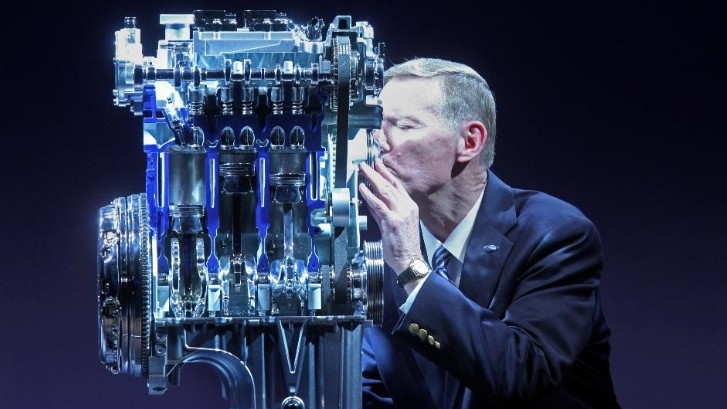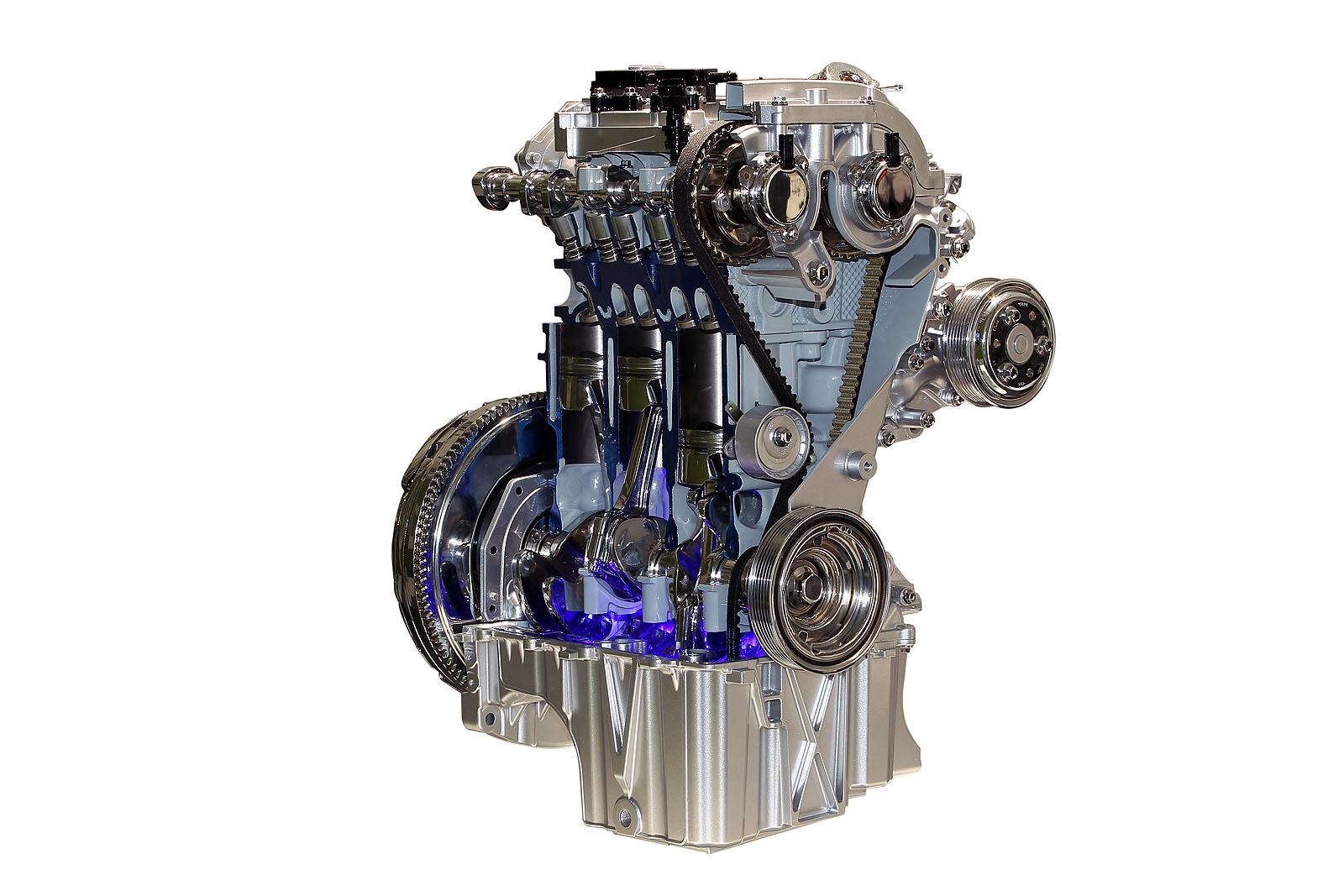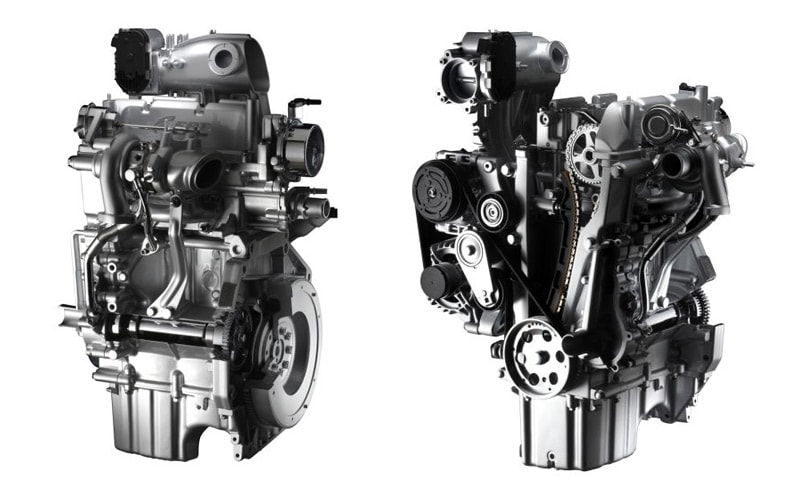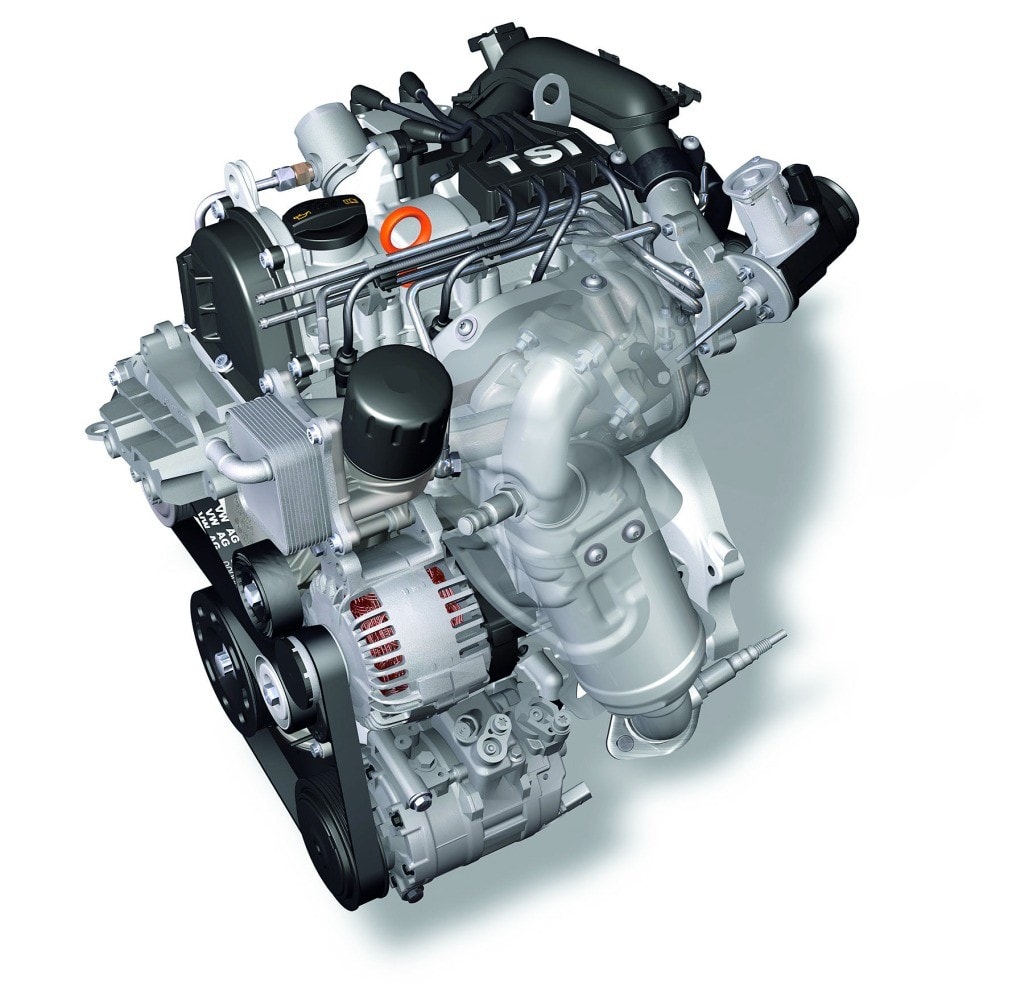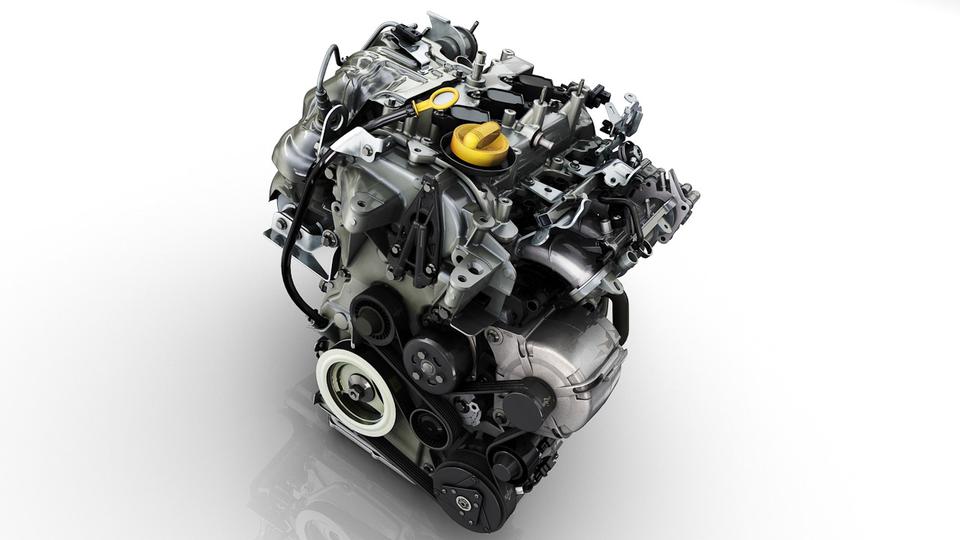This year has seen an explosion in the number of turbocharged small displacement petrol engines available under the bonnets of new cars. Ford, Fiat, the Volkswagen Group brands, some of the GM brands and Renault have already launched many small displacement turbo units, and their number is set to grow, as is the number of increasingly larger cars they are used in.
The basic idea behind them is to offer power and torque levels comparable or better than those provided by naturally-aspirated units, of larger displacement, while keeping the fuel consumption low, and using a turbocharger or supercharger, or both, to get more fuel into the actual cylinders only when needed. It is gaining widespread adoption, and soon all manufacturers will offer only engines with forced induction - some are quite close to achieving this, already - VW.
Volkswagen was the first to put a small displacement turbo petrol under the bonnet of a large car, when they began offering the Passat in both sedan and estate guises with their 1.4-liter TSI engine, with 122 hp. They are currently the only ones to offer a sub 1.6-liter engine in a D-segment car, yet that’s all about to change once the new Ford Mondeo finally enters production, as it will get an amazingly small engine, given its size – the excellent 1.0-liter EcoBoost unit, with 125 hp.
Since Ford was brought into discussion, we shall begin by talking about their range of EcoBoost engines, which range in size from 1063cc to 3496cc. The first and most talked-about engine they currently offer is also the smallest one they offer – the one-liter unit. It is currently used in the Fiesta supermini and B-Max mini-MPV, and it is available with either 100 hp or 125 hp, yet it is only available with a five-cog gearbox.
Superchips have managed to push the little three-pot unit to 145 hp without a hitch, while Ford themselves have pushed it to the 200 hp mark, in one of their single-seater racing cars. The award-winning engine will probably make its way under the bonnets of more Fords over the coming years, and we are curious to see how far they will push it – a 150 hp variant would be nice, especially for a Fiesta, as it would offer better performance than a naturally-aspirated two-liter unit, while also not weighing down the front axle too much, thus keeping the car’s responses sharp and accurate.
Ford’s other engines are a bit more conventional, yet they are equally impressive. The 1.6-liter unit makes either 150 or 180 hp, and it is available in the Focus, Escape and Fusion, the C-Max and S-Max MPVs, as well as the Volvo V40, S60, V60 and S80. The larger 2.0-liter unit has 200 or 240 hp, and it is highly-impressive, even in standard form, while under the bonnet of the new Focus ST, it has been given an additional 10 hp, and it makes a great growl when pushed, making it a very fun engine to have.
It is also used in a variety of larger Ford cars and SUVs, as well as the Range Rover Evoque and the Volvo S60 and V60. The largest of Ford’s EcoBoost units, the 3.5-liter, with an output of 365 hp has V8 levels of power and superior torque, and it is used by both Ford and Lincoln, under the bonnet of some of their larger offerings.
Next up we have Fiat, with their excellent TwinAir 0.9-liter turbocharged two-pot unit, which gives you a nice rumbly motorbike soundtrack, yet it is refined and powerful enough to make it a very good long journey companion. Still, driving cars like the 500, Punto and Panda, it is clear that it does what it does best in town, where it is far nippier than its very small displacement would suggest. Fiat also have their excellent 1.4-liter MultiAir engine, with power outputs ranging from 120 to 170 hp, with the latter powering the hot version of the Alfa Romeo Mito QV, as well as the best-balanced Alfa you can currenlty buy – the Giulietta, which works very well when powerred by this particular unit, which gives it near-hot hatch pace, yet fuel consumption remains reasonable, and it may even surprise some that a car which can do 0-100km/h in 7.8 seconds can still return a realistic 40 mpg or 5.8 l/100km, if you are careful with the throttle, and there’s not a lot of traffic.
Volkswagen also has a wide assortment of turbocharged engines, with their 1.2 TSI, 1.4 TSI, 1.8 TSI and 2.0 TSI, found under the bonnet of most of their models – very soon, they will probably stop offering naturally-aspirated engines altogether, and we expect them to be the first manufacturer in the world to completely give up their use. They are currently the closest to achieving this goal, and it is a safe assumption that they will make a big deal out of this, once they actually get there.
Renault has also added two very interesting units to their lineup of engines, this year – the 0.9-liter TCE90, and the 1.2-liter TCE115, which make 90 hp and 115 hp respectively. The smaller displacement unit is more interesting, and we are very eager to get our hands on a car equipped with it, preferably the new Clio or the Dacia Sandero. The French automaker has also surprised the automotive industry by offering the TCE90 (which is built in Romania) under the bonnet of the Dacia Sandero and Logan, which is odd, considering their ‘low cost’ philosophy.
We are curious to see what Honda’s upcoming turbocharged petrol units will be like, since they have been very reluctant to adopt turbocharging, until now. However, given their history of making great engines, we expect their force-fed motors to be just as competent. Once it arrives, in addition to the Japanese automaker’s equally-new 1.6-liter diesel, it will give the excellent Civic much more appeal for European buyers.
These engines represent the (near) future, and they are an important step towards reducing our dependency on oil, before we finally give up its use altogether. However, we sadly will not live to see it, but it is nevertheless important to encourage their adoption and use, as an important stepping stone. This is not a difficult task, though, as they don`t really have any drawbacks to speak of, other than their increased complexity, which makes them prone to failing.
Still, we say that in the next 10 years, there will be no more naturally-aspirated engines, and they will probably shrink even further, and a under 500cc single-cylinder engine, fitted with some sort of forced induction or/or small electric motor, producing around 100 hp may become the norm.
Renault TCE90
Ford 1.0-Liter EcoBoost
Volkswagen was the first to put a small displacement turbo petrol under the bonnet of a large car, when they began offering the Passat in both sedan and estate guises with their 1.4-liter TSI engine, with 122 hp. They are currently the only ones to offer a sub 1.6-liter engine in a D-segment car, yet that’s all about to change once the new Ford Mondeo finally enters production, as it will get an amazingly small engine, given its size – the excellent 1.0-liter EcoBoost unit, with 125 hp.
Since Ford was brought into discussion, we shall begin by talking about their range of EcoBoost engines, which range in size from 1063cc to 3496cc. The first and most talked-about engine they currently offer is also the smallest one they offer – the one-liter unit. It is currently used in the Fiesta supermini and B-Max mini-MPV, and it is available with either 100 hp or 125 hp, yet it is only available with a five-cog gearbox.
Superchips have managed to push the little three-pot unit to 145 hp without a hitch, while Ford themselves have pushed it to the 200 hp mark, in one of their single-seater racing cars. The award-winning engine will probably make its way under the bonnets of more Fords over the coming years, and we are curious to see how far they will push it – a 150 hp variant would be nice, especially for a Fiesta, as it would offer better performance than a naturally-aspirated two-liter unit, while also not weighing down the front axle too much, thus keeping the car’s responses sharp and accurate.
Ford’s other engines are a bit more conventional, yet they are equally impressive. The 1.6-liter unit makes either 150 or 180 hp, and it is available in the Focus, Escape and Fusion, the C-Max and S-Max MPVs, as well as the Volvo V40, S60, V60 and S80. The larger 2.0-liter unit has 200 or 240 hp, and it is highly-impressive, even in standard form, while under the bonnet of the new Focus ST, it has been given an additional 10 hp, and it makes a great growl when pushed, making it a very fun engine to have.
It is also used in a variety of larger Ford cars and SUVs, as well as the Range Rover Evoque and the Volvo S60 and V60. The largest of Ford’s EcoBoost units, the 3.5-liter, with an output of 365 hp has V8 levels of power and superior torque, and it is used by both Ford and Lincoln, under the bonnet of some of their larger offerings.
Next up we have Fiat, with their excellent TwinAir 0.9-liter turbocharged two-pot unit, which gives you a nice rumbly motorbike soundtrack, yet it is refined and powerful enough to make it a very good long journey companion. Still, driving cars like the 500, Punto and Panda, it is clear that it does what it does best in town, where it is far nippier than its very small displacement would suggest. Fiat also have their excellent 1.4-liter MultiAir engine, with power outputs ranging from 120 to 170 hp, with the latter powering the hot version of the Alfa Romeo Mito QV, as well as the best-balanced Alfa you can currenlty buy – the Giulietta, which works very well when powerred by this particular unit, which gives it near-hot hatch pace, yet fuel consumption remains reasonable, and it may even surprise some that a car which can do 0-100km/h in 7.8 seconds can still return a realistic 40 mpg or 5.8 l/100km, if you are careful with the throttle, and there’s not a lot of traffic.
Volkswagen also has a wide assortment of turbocharged engines, with their 1.2 TSI, 1.4 TSI, 1.8 TSI and 2.0 TSI, found under the bonnet of most of their models – very soon, they will probably stop offering naturally-aspirated engines altogether, and we expect them to be the first manufacturer in the world to completely give up their use. They are currently the closest to achieving this goal, and it is a safe assumption that they will make a big deal out of this, once they actually get there.
Renault has also added two very interesting units to their lineup of engines, this year – the 0.9-liter TCE90, and the 1.2-liter TCE115, which make 90 hp and 115 hp respectively. The smaller displacement unit is more interesting, and we are very eager to get our hands on a car equipped with it, preferably the new Clio or the Dacia Sandero. The French automaker has also surprised the automotive industry by offering the TCE90 (which is built in Romania) under the bonnet of the Dacia Sandero and Logan, which is odd, considering their ‘low cost’ philosophy.
We are curious to see what Honda’s upcoming turbocharged petrol units will be like, since they have been very reluctant to adopt turbocharging, until now. However, given their history of making great engines, we expect their force-fed motors to be just as competent. Once it arrives, in addition to the Japanese automaker’s equally-new 1.6-liter diesel, it will give the excellent Civic much more appeal for European buyers.
These engines represent the (near) future, and they are an important step towards reducing our dependency on oil, before we finally give up its use altogether. However, we sadly will not live to see it, but it is nevertheless important to encourage their adoption and use, as an important stepping stone. This is not a difficult task, though, as they don`t really have any drawbacks to speak of, other than their increased complexity, which makes them prone to failing.
Still, we say that in the next 10 years, there will be no more naturally-aspirated engines, and they will probably shrink even further, and a under 500cc single-cylinder engine, fitted with some sort of forced induction or/or small electric motor, producing around 100 hp may become the norm.
Renault TCE90
Ford 1.0-Liter EcoBoost
